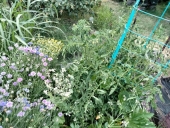

Anne Miller wrote:I hope that by bumping your topic with this information there might be more discussions.
There may not be a lot of discussion on crop rotation because there is more talk about planting perennial vegetables and planting polycultures.
I am a believer in practicing methods for soil health so I feel crop rotation of annual plants might be necessary depending on the plants.
Maybe some plants use more of the nutrients than others making it a necessity to rotate to something else the next years.
It seems that the permaculture answer to this is to plant perennials.
Though promoting perennials this article says it is a 4-year plan.
common collection for us to consider now for a basic four-year rotation plan.
• Nightshades (Solanaceae): potatoes, tomatoes, peppers, eggplant
• Cruciferous (Brassicaceae): kale, cabbages, broccoli, cauliflower, mustard
• Legumes (Fabaceae): green beans, garden peas, snow peas, kidney beans, lentils
• Roots (Amaryllidaceae): onions, leeks, garlic, (Apiaceae): beets, parsnips, celery, carrots and (Chenapodiaceae): beets
https://www.permaculturenews.org/2016/11/18/rotate-annual-crops/
Bonnie Plants offers an easy plan using 4 crops that are rotated every planting:
One approach to crop rotation is to divide your plants into these four basic groups: legumes, root crops, fruit crops, and leaf crops. Imagine your garden separated into four areas, as shown in the chart at the top of the page. Each successive year, you would move each group one spot clockwise. So, for example, you would plant your legumes in Area 1 one year, then the next year you’d move them to Area 2 while the leaf crops from Area 4 moved into now-vacant Area 1—and so on.
https://bonnieplants.com/the-bonnie-blog/crop-rotation-made-easy/
It makes sense to me that different plants use different nutrients so rotating plants every year seems logical.
Matt McSpadden wrote:Hi Allen,
I'm actually going to take a step back and ask a different question. Why would we want to do crop rotation at all? The two problem reasons that I know of, to do crop rotation is to avoid diseases and to deal with nutrient deficiencies. And those aren't that big of a deal.
In the first case, with diseases, if you don't have a disease in a certain spot, then there is no need to rotate. If there is a disease in a spot, at a home garden scale, moving it over 5 feet may not be effective enough.
As for nutrient deficiencies, these should not be a big deal if one is gardening in an organic manner to feed the soil. You will be increasing microbiology and adding things like compost, which will even out the availability of the nutrients.
Now for there are some beneficial reasons like loosening soil and increasing nitrogen. If you simply cut off the tops of legumes, the nitrogen around their roots will become available for the next plants. If you plant certain root crops they can loosen the soil for the next crop. There is also benefits to inter-planting crops to attract beneficial bugs and confuse the bad bugs.
That is the long way of saying that I do it in my garden, and I believe it to be beneficial, but both the problems and the benefits are much less on a small scale than they are on a large scale.
I wish you the best of luck with gardening.


Riona Abhainn wrote:While I don't know all these answers off the top of my head I wanted to say welcome to the forums here, and someone much smarter than I will likely get back to you soon with some good info.